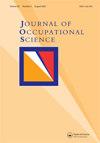Harnessing the pedagogical power of art for learning about occupation in an entry-to-practice neurorehabilitation occupational therapy course
IF 2.9
Q1 SOCIAL SCIENCES, INTERDISCIPLINARY
引用次数: 0
Abstract
ABSTRACTIntroduction: Art can be a transformative pedagogical tool for teaching occupation. Research on arts-based pedagogies to teach occupation within educational programs is emergent and remains limited.Objectives To explore the use of art created by people with acquired brain injury to develop understandings of the lived experiences and occupational impacts of acquired brain injury for graduate students in an entry-to-practice occupational therapy graduate program.Methods First, development of the arts-based pedagogical tool was undertaken through an online review to select works of art that reflected acquired brain injury experience as depicted by people with lived experience. These art pieces were then used to develop a class that facilitated learning of the occupational impacts of acquired brain injury in an entry-to-practice occupational therapy graduate program. A descriptive qualitative approach was then used to explore the learning experiences of five graduate students who participated in a focus group. Reflexive thematic analysis was used to understand the data.Findings: Art facilitated transformative learning experiences for students and was described by three themes: (1) captivating the learner, (2) “whole ‘nother layer”, and (3) inviting exploration and expansion.Conclusions Arts-based pedagogy holds potential to be an enriching teaching and learning tool for critically reflexive engagement, awareness, and deep understanding of the lived experiences and occupational impacts experienced by individuals with acquired brain injury.RESUMEIntroduction: l'art peut être un outil pédagogique transformateur pour l'enseignement des occupations. La recherche sur les pédagogies fondées sur l'art pour enseigner les occupations dans les programmes éducatifs est émergente et reste limitée.Objectifs: explorer l'utilisation de l'art créé par des personnes ayant subi une lésion cérébrale acquise pour développer une compréhension des expériences vécues et des impacts occupationnels de la lésion cérébrale acquise pour les étudiant·es dans un programme d'ergothérapie d'entrée dans la pratique.Méthodes: tout d'abord, le développement de l'outil pédagogique fondé sur l'art a été entrepris par le biais d'une recension en ligne afin de sélectionner des œuvres d'art qui reflètent l'expérience des lésions cérébrales acquises telle qu'elle est décrite par les personnes ayant une expérience vécue. Ces œuvres d'art ont ensuite été utilisées pour développer un cours qui facilite l'apprentissage des impacts occupationnels des lésions cérébrales acquises dans le cadre d'un programme de formation en ergothérapie. Une approche qualitative descriptive a ensuite été utilisée pour explorer les expériences d'apprentissage de cinq étudiant·es diplômé·es qui ont participé à un groupe de discussion. Une analyse thématique réflexive a été utilisée pour comprendre les données.Résultats: l'art a facilité les expériences d'apprentissage transformatrices pour les étudiant·es et a été décrit par trois thèmes : (1) captiver l'apprenant·e, (2) “plonger en profondeur”, et (3) inviter à l'exploration et à l'expansion.Conclusions: la pédagogie basée sur les arts a le potentiel d'être un outil d'enseignement et d'apprentissage enrichissant pour l'engagement réflexif critique, la prise de conscience et la compréhension profonde des expériences et des impacts occupationnels vécus par les personnes souffrant de lésions cérébrales acquises.KEYWORDS: Occupational scienceArts-based pedagogyTransformative educationReflective learningAcquired brain injuryMOTS CLÉS: Science de l'occupationpédagogie fondée sur les artséducation transformatriceapprentissage réflexiflésions cérébrales acquises AcknowledgementsWe begin by acknowledging that the land on which we study, gather, and learn is the traditional, ancestral, and unceded territory of the xwməθkwəy̓əm (Musqueam) People, Skwxwú7mesh (Squamish), Stó:lō and Səl̓ílwətaʔ/Selilwitulh (Tsleil-Waututh) Nations. We each commit to ongoing reflexive action toward reconciliation on the land colonially known as Canada.The completion of this research endeavour could not have been possible without the participants; we are so appreciative of your time and thoughtfulness. We would also like to recognize the artists who were open with their artwork and their stories. Thank you for sharing your art with the world and making a difference among future occupational therapists. Thank you especially to Tony Allen, Sam Jevon, and Chris Miller who gave us the honour of including their pieces in our manuscript. To explore more artwork from these artists please visit https://www.submittolovestudios.org/Disclosure StatementNo potential conflict of interest was reported by the author(s).Conflict of InterestNone to declare.在进入实践的神经康复职业治疗课程中,利用艺术的教学力量来学习职业
摘要导读:艺术可以成为职业教学的变革性教学工具。在教育项目中,以艺术为基础的职业教学方法的研究是新兴的,而且仍然有限。目的探讨利用获得性脑损伤患者创作的艺术来帮助研究生了解获得性脑损伤的生活经历和职业影响。方法首先,通过在线审查,选择反映获得性脑损伤经历的艺术作品,开发基于艺术的教学工具,这些经历是由有生活经历的人描述的。然后,这些艺术作品被用来发展一个班级,促进学习获得性脑损伤的职业影响,在一个进入实践的职业治疗研究生项目中。然后使用描述性定性方法来探讨参加焦点小组的五名研究生的学习经历。使用反身性主题分析来理解数据。研究发现:艺术促进了学生的变革性学习体验,并由三个主题来描述:(1)吸引学习者,(2)“完整的另一层”,(3)邀请探索和扩展。基于艺术的教学法有潜力成为一种丰富的教学和学习工具,用于批判性反思参与、意识和对后天脑损伤个体的生活经历和职业影响的深刻理解。简历简介:l'art peut être unoutil psamdagogique transformeur pour l'enseignement des occupations。研究确定了所有的交换条件,例如:交换交换条件,交换交换条件,交换交换条件,交换交换条件,交换交换条件,交换交换条件,交换交换条件。目的:探索者的利用,从个人的角度出发,从个人的角度出发,从个人的角度出发,从个人的角度出发,从个人的角度出发,从个人的角度出发,从个人的角度出发,从个人的角度出发,从个人的角度出发,从个人的角度出发,从个人的角度出发,从个人的角度出发,从个人的角度出发。3 .在国外,将所有的 或以上的 /或以上的 /或以上的 /或以上的 /或以上的 /或以上的 /或以上的 /或以上的 /或以上的 /或以上的 /或以上的 /或以上的 /或以上的 /或以上的 /或以上的 /或以上的 /或以上的 /或以上的 /或以上的 /或以上的 /或以上的。在培训课程中,通过培训,通过培训,通过培训,通过职业培训,通过培训,通过培训,通过培训,通过培训,通过培训,通过培训,通过培训,通过培训,通过培训,通过培训,通过培训,通过培训,通过培训,完成培训。一种定性描述的方法是:一种套间的交换交换,即交换交换,交换交换,交换交换,交换交换,交换交换,交换交换,交换交换,交换交换。我们可以分析一下, - - - - - - - - - - - - - - - - - - - - - - - - - - -(1)“俘虏”(1)“俘虏”(1)“俘虏”(2)“长而深”(3)“邀请者”(4)“探索”(4)“扩张”(3)。结论:在不同的职业中,不同的职业有不同的经历,不同的职业有不同的经历,不同的职业有不同的经历,不同的职业有不同的经历,不同的职业有不同的经历,不同的职业有不同的经历,不同的职业有不同的经历,不同的职业有不同的经历,不同的职业有不同的经历,不同的职业有不同的经历,不同的职业有不同的经历。关键词:职业科学;以心为本;变革教育;反思学习;我们首先承认,我们学习、聚集和学习的土地是xwm æ θkw æ y æ m (Musqueam)人、Skwxwú7mesh (Squamish)、Stó: lhi和S æ l æ ílw æ ta æ /Selilwitulh (Tsleil-Waututh)民族的传统、祖先和未被割让的领土。我们每个人都承诺为在殖民地称为加拿大的土地上实现和解而不断采取反思行动。没有参与者,这项研究的完成是不可能的;我们非常感谢你的时间和周到。我们也想承认那些对自己的作品和故事持开放态度的艺术家。感谢您与世界分享您的艺术,并在未来的职业治疗师中发挥作用。特别感谢Tony Allen, Sam Jevon和Chris Miller,他们给了我们在我们的手稿中收录他们作品的荣誉。欲了解这些艺术家的更多作品,请访问https://www.submittolovestudios.org/Disclosure声明作者未报告潜在的利益冲突。利益冲突无需申报。
本文章由计算机程序翻译,如有差异,请以英文原文为准。
求助全文
约1分钟内获得全文
求助全文
来源期刊

Journal of Occupational Science
SOCIAL SCIENCES, INTERDISCIPLINARY-
CiteScore
4.30
自引率
41.70%
发文量
46
 求助内容:
求助内容: 应助结果提醒方式:
应助结果提醒方式:


